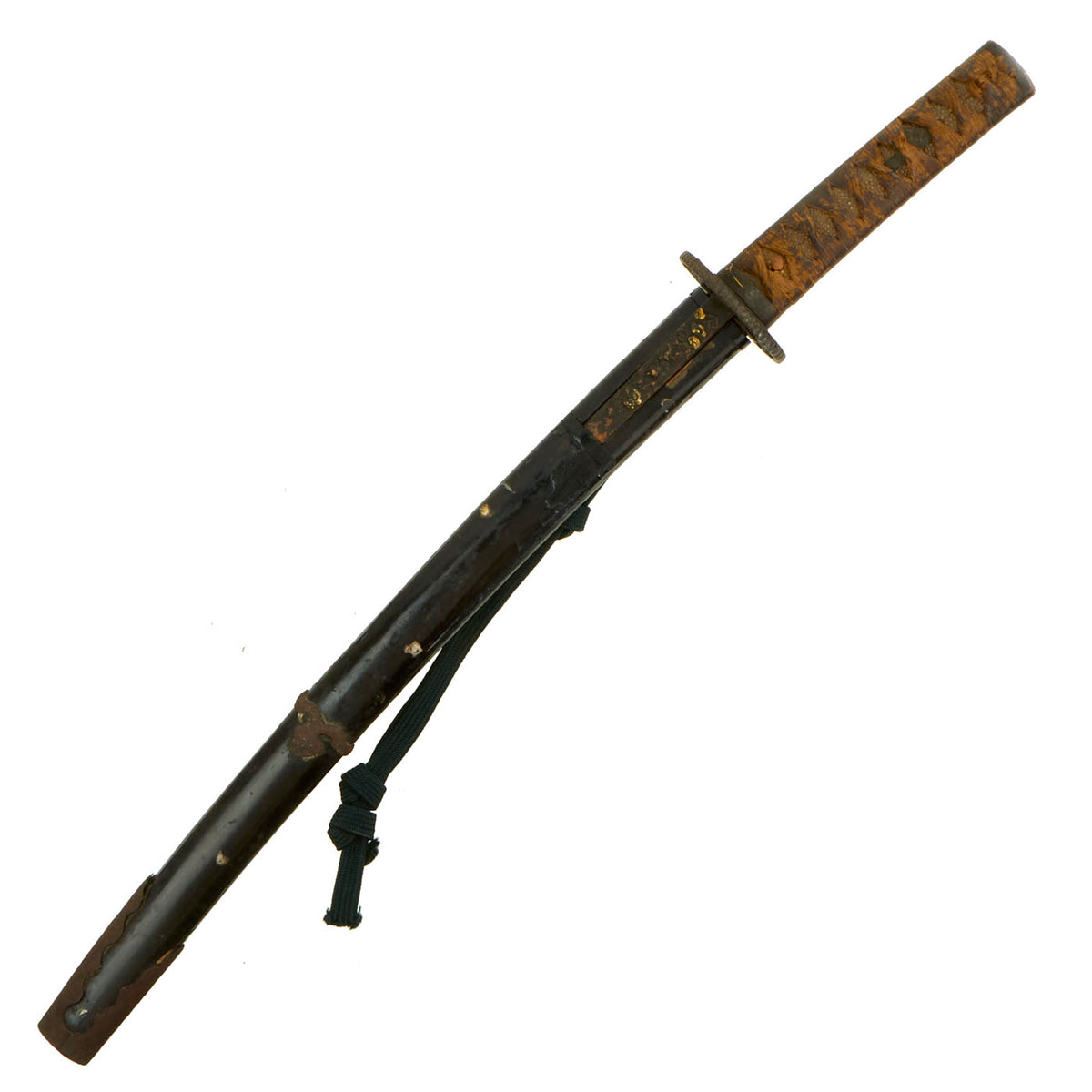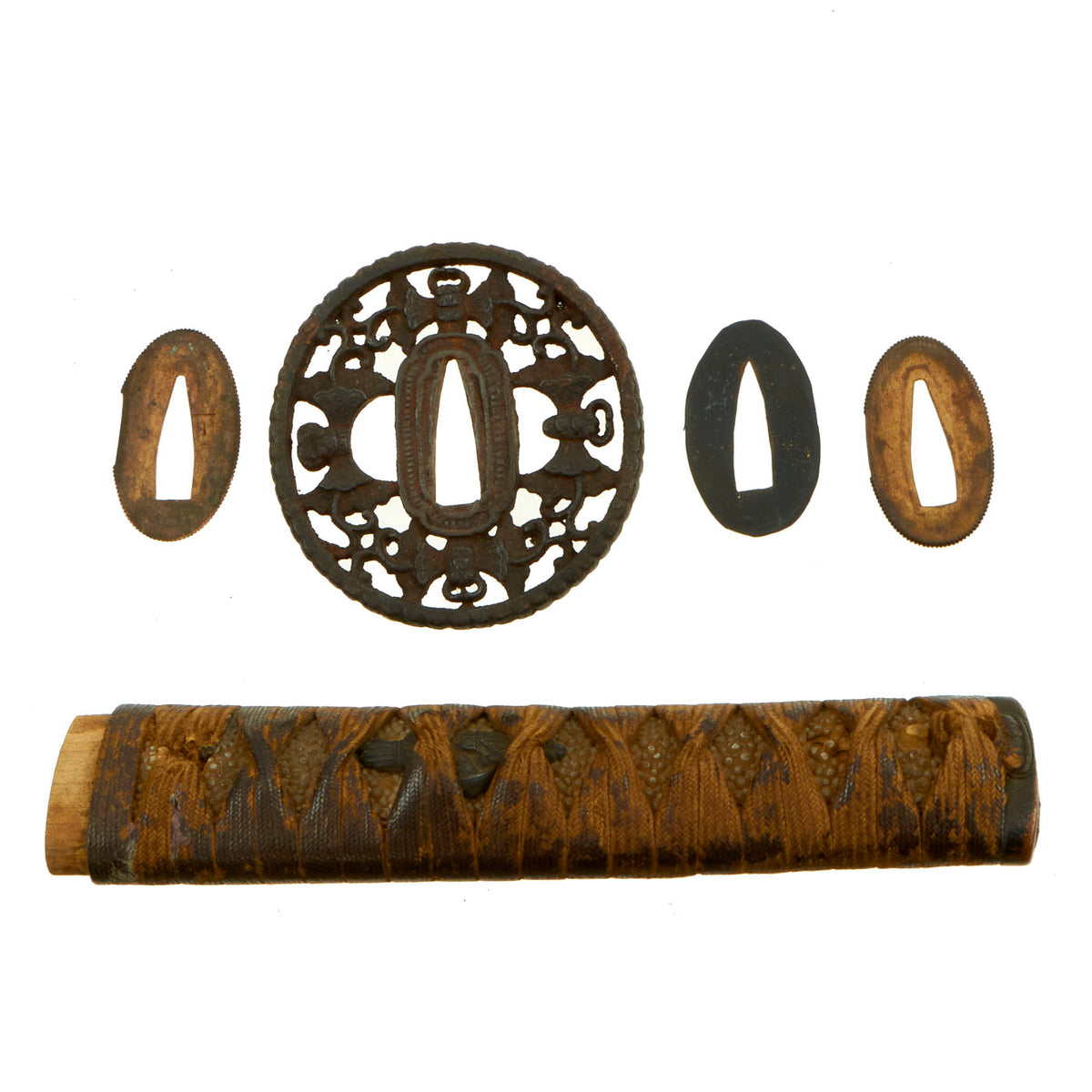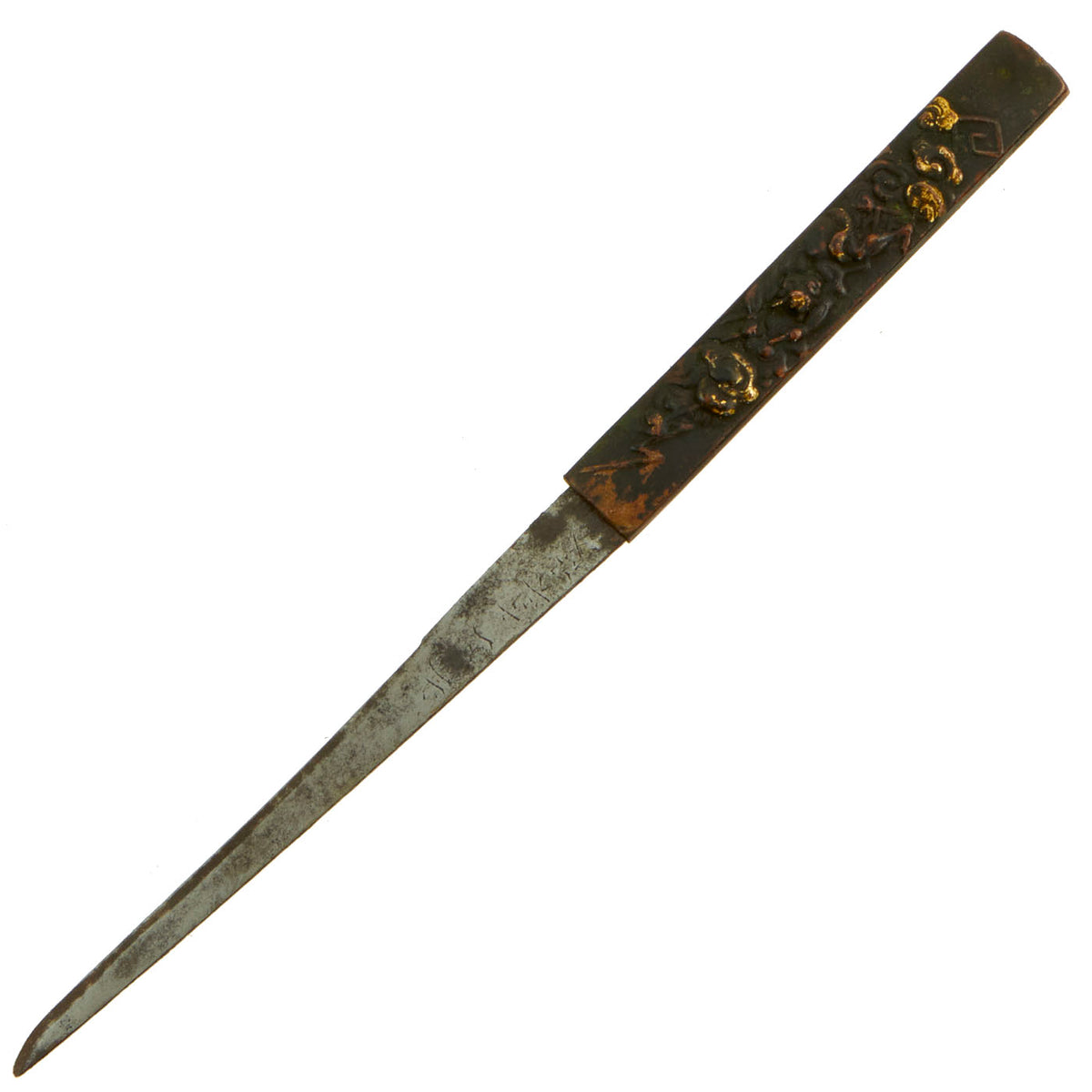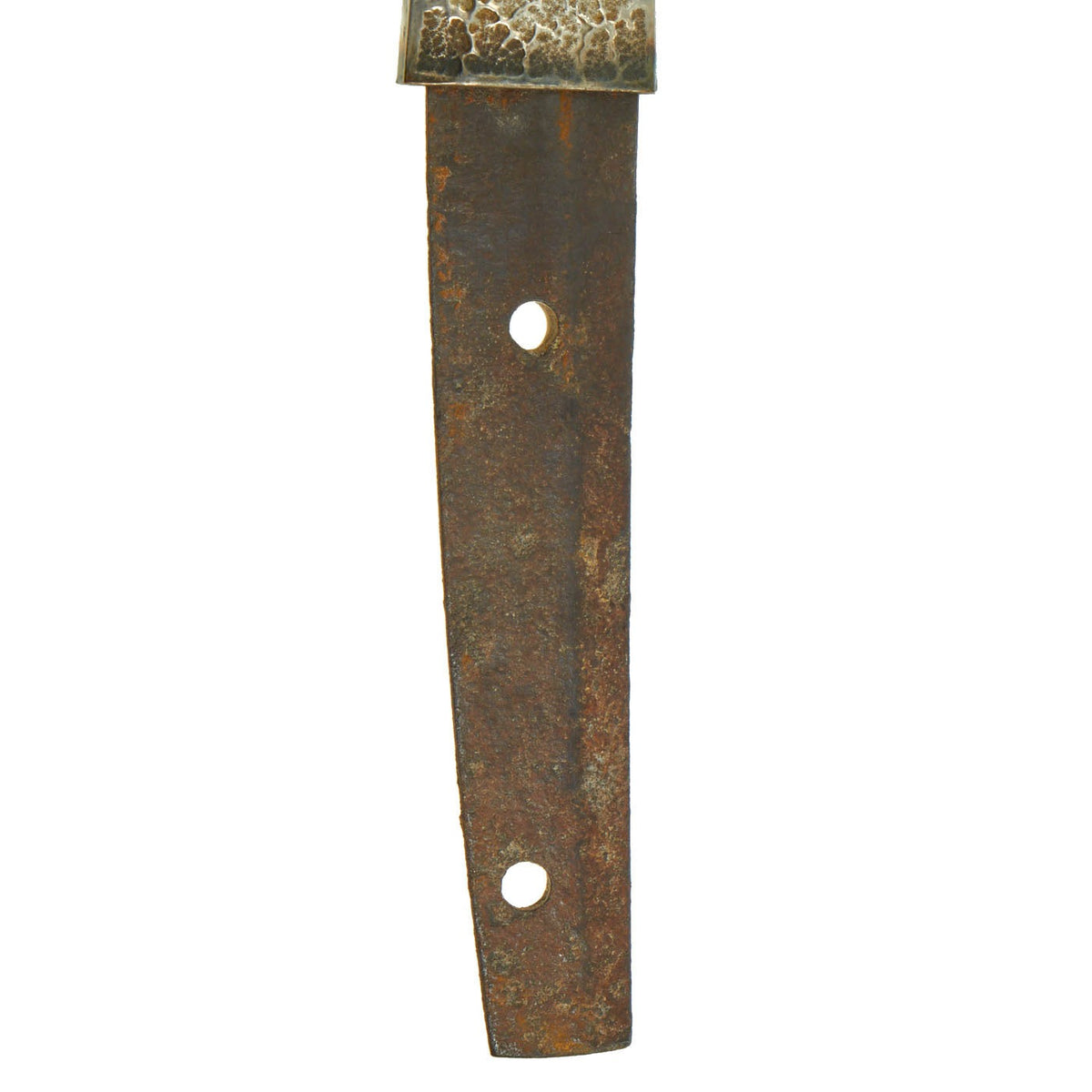Original 15th – 16th Century Japanese Handmade Wakizashi Short Sword with Kogatana Knife, Scabbard & Sageo Cord Original Items
$ 1.995,00 $ 498,75
Original Item: Only One Available. Wakizashi (脇差 “side inserted / companion sword”) is a general term for a sword with an edge between one and two shaku long (30 cm and 60 cm), predominantly made after 1600. Generally it is the short blade that accompanies a katana in the traditional samurai daisho pairing of swords, but may be worn by classes other than the samurai as a single blade, also worn edge up as the katana. Here we have a wonderful example, in great polish, and complete with all the usual accessories, including a kogatana knife and a sageo sword cord.
We had this sword examined, and we believe this example dates from the Muromachi period (室町時代 Muromachi jidai) of 1336 to 1573, during the middle circa 1450. This is part of the period of Japanese swordmaking known as Kotō (古刀”old swords”), the the type of swords that later smiths treated as the goal they needed to achieve. The fittings may be of later manufacture, but are still centuries old.
This example has most likely been remounted several times, as was common for Japanese blades. This has made the file marks (yasurimi) on the tang faint, and given it a lovely patina. Looking at the overall shape and the tang this blade was once longer, and was cut down through the process of SURIAGE. If a blade is shortened, it can only be done from the tang end, to preserve the tip of the blade (kissaki) and tip temper line (boshi). The tang on such a blade is cut straight across at the bottom (kiri).
There are two holes in the tang, and it is possible that the sword has been cut down more than once. This almost certainly removed the name of the maker, and as it is unsigned, this blade is considered 無名 (mumei), or “anonymous”. It has a “Shinogi Zukuri blade shape, which has a blade ridge (shinogi), and is the same basic shape used by the majority the longer katana swords.
The blade has the following period correct features:
– Folded steel blade (fold lines are evident on the spine and body of the blade)
– Holes (mekugi-ana) in the tang are punched and not drilled
– Visible temper line (“hamon”) running full length of blade cutting edge, with lots of internal activity.
– Hada or Grain is visible throughout the blade surface.
– Blade wounds (kizu) or lamination artifacts are present on the blade. Both ware (lamination lines) and fukure (carbon pits) are visible.
Offered in great condition, the blade of this example is in excellent polish, and shows only tiny spots of oxidation and scuffing. The edge is still quite sharp, so care is needed, and there are no nicks or other damage we can see. Blade length is approximately 18 1/2″ and overall length 27″. It has a futsu 普通 (regular) Nakago with a kiri (cut) nakago-jiri.
The blade has a vibrant visible hamon (temper line), which is a lovely NOTARE (wave or swell) type, with a lot of internal activity. There are multiple lamination lines along the blade, and there are clear NIE crystals along the temper line, and the correct NIOI cloudiness. It has a clear yokote dividing the geometric kissaki (tip) from the rest of the blade. The blade shows ITAME (wood grain) hada (grain) on the body, and it has a YAKIZUME (no turnback) boshi. There are blade wounds including ware (lamination splits) and fukure (Carbon pits), especailly on the shinigo-ji area of the blade. Really a very nice blade here! The sword has a silver Habaki (blade collar), which is typical of very old blades.
The tsuba (cross guard) is made of iron and is of the Maru Gata (round) shape. It is perforated, showing lots of insect designs, and is clearly VERY old based on the patina. The tsuba has hitsu-ana holes on each side for accessories, which theoretically allow them to be taken out without removing the sword, though in this case it runs into the crossguard. There are two seppa around the tsuba, as well as a rubber insert to keep it from wobbling.
The fuchi (collar) for the tsuka (handle) and the Kashira (End Cap), are both also made of iron, with lovely gold inlaid designs. There are two brass menuki grip ornaments present, which look to be peasants carrying bundles of wood. The stingray (Sa-Me) grip is in very good condition, with a nice Ito (cloth binding), which shows a lot of wear from age and use.
The sword comes in a a well fitting black enamel lacquer wooden scabbard (saya), which has iron fittings on the outside that show great age. The scabbard is in very good condition, and looks to have some small pieces of inlaid mother of pearl scattered over the surface. It has been repainted at least once, and it can be seen that the paint was flaking before the repaint. It has a kurikata (knob) with an attached sageo (sword cord).
The Kogatana accessory knife is in good condition, and the blade on this example is signed as well! Unfortunately it is somewhat faded and in Japanese “cursive” script, so we are not able to read it. There is a bit of staining, but nothing major. The Kozuka (grip) can be removed to look at the tang, and is in good condition. The design motif on the handle shows lightning and storm clouds, possibly with a mythical creature in the middle.
A nice late Muromachi Period wakizashi, complete with scabbard, kogatana, and sageo cord! This is the complete setup, ready to display!
Specifications (Wakizashi):
Blade Length: 18 1/2″
Blade Shape: Shinogi Zukuri
Overall length: 26 1/4“
Scabbard Length: 19 1/2″
Specifications (Kogatana):
Blade Length: 4 5/8″
Overall Length: 8 1/2″
It has been over one thousand years ago that the art of making swords appeared in Japan. The swordsmiths of the time may not have known it but they were creating a legendary sword. The Samurai sword has seen combat in many battlefields. From the early days of the Samurai warrior to the fierce battles in the South Pacific during WWII.
Each hand-made Japanese blade (日本刀 – Nihonto) is unique because it is forged from multiple pieces of folded steel stock. A tremendous amount of work is dedicated to creating these pieces. They were an instrument of war as much as a beautiful artifact to adorn a room.
The traditional Japanese blade and mountings have grown to be one of the most highly desired military antiques.
Fast Shipping with Professional Packaging
Thanks to our longstanding association with UPS FedEx DHL, and other major international carriers, we are able to provide a range of shipping options. Our warehouse staff is expertly trained and will wrap your products according to our exact and precise specifications. Prior to shipping, your goods will be thoroughly examined and securely secured. We ship to thousands clients each day across multiple countries. This shows how we're dedicated to be the largest retailer on the internet. Warehouses and distribution centres can be located throughout Europe as well as the USA.
Note: Orders with more than one item will be assigned a processing date depending on the item.
Before shipping before shipping, we'll conduct a thorough inspection of the items you have ordered. Today, the majority of orders will be delivered within 48 hours. The delivery time will be between 3-7 days.
Returns
The stock is dynamic and we cannot completely manage it because multiple stakeholders are involved, including our factory and warehouse. So the actual stock may alter at any time. It's possible that you may not receive your order once the order has been made.
Our policy is valid for a period of 30 days. If you don't receive the product within 30 days, we are not able to issue a refund or an exchange.
You can only return an item if it is unused and in the same state as the day you received it. You must have the item in its original packaging.
Related products
Uncategorized
Uncategorized
Uncategorized
Uncategorized
Uncategorized
Armored Burgonet Helmet & Polearm from Scottish Castle Leith Hall Circa 1700 Original Items
Uncategorized
Uncategorized
Uncategorized
Armoured Fighting Vehicles of the World: AFVs of World War One (Hardcover Book) New Made Items
Uncategorized
Band of Brothers ORIGINAL GERMAN WWII Le. F.H. 18 10.5cm ARTILLERY PIECE Original Items
Uncategorized
Uncategorized
Uncategorized
Uncategorized
Uncategorized
Uncategorized
Uncategorized
Uncategorized
Uncategorized
Angolan Rebel 1970s era 60mm Inert Display Mortar from Angolan Civil War Original Items












































































